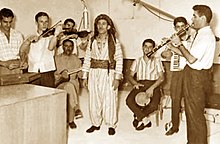Kurdish music (Sorani Kurdish: میوزیکی کوردی) refers to music performed in the Kurdish languages and Zaza-Gorani languages. The earliest study of Kurdish music was initiated by the renowned Armenian priest and composer Komitas in 1903, when he published his work "Chansons kurdes transcrites par le pere Komitas" which consisted of twelve Kurdish melodies which he had collected. The Armenian Karapetê Xaço also preserved many traditional Kurdish melodies throughout the 20th century by recording and performing them. In 1909, Scholar Isya Joseph published the work "Yezidi works" in which he documented the musical practice of the Yazidis including the role of the musician-like qewal figures and the instruments used by the minority.
Kurdish music appeared in phonographs in the late 1920s, when music companies in Baghdad began recording songs performed by Kurdish artists.
Despite being secondary to vocals, Kurds use many instruments in traditional music. Musical instruments include the tembûr (see kurdish tanbur), bağlama, qernête, daf, duduk, kaval, long flute (şimşal), kemenche, oboe (zirne) and drum (dahol).

Definition
See also: Siyaw ChemaneTraditional Kurdish music is culturally distinct from Arabic, Armenian and Turkish music, and mostly composed by people who remained anonymous. Thematically, the music were of melancholic and elegiac character, but has since then incorporated more upbeat and joyous melodies.
Kurdish folklore consists of three genres: the storytellers (çîrokbêj), bards (dengbêj) and popular singers (stranbêj).
Moreover, there are religious-themed songs (lawje) seasonal musical topics, for example "payizok" that are songs about the return to the summer pastures performed in autumn. Kurdish improvisations are called teqsîm.
Prohibition
In Iraq, tolerance for Kurdish music ceased with the Saddam regime (1979–2003) which put in place restrictions against Kurdish culture. Between 1982 and 1991 the performance and recording of songs in Kurdish was also banned in Turkey.
See also
References
- Robert F. Reigle (2013). "A brief history of Kurdish music recordings in Turkey". Hellenic Journal of Music Education, and Culture. 4 (2). ISSN 1792-2518.
- Lewkowitz, Joshua (30 May 2019). "Who are the heroes, hustlers and innovators of Kurdish wedding music?". Al-Monitor. Retrieved 18 July 2019.
- Sylvia Angelique Alajaji (2015). Music and the Armenian diaspora : searching for home in exile. Indiana University Press. p. 168. ISBN 978-0253017765.
- Komitas (1903). "Mélodies kurdes recueillies par Archimandrite Comitas" (PDF) (in Armenian). Retrieved 18 July 2019.
- Salih Kevirbirı̂ (2002). Karapetê Xaço: bir çiǧliǧin yüzyili (in Turkish). Sı̂ Yayınları.
- Mohammad Ali Merati (2015). "Les formes fondamentales de la musique kurde d'Iran et d'Irak : hore, siâw-çamane, danses, maqâm" (PDF). Milieux cultures et sociétés du passé et du présent (in French). L'Université Paris Nanterre. Retrieved 19 July 2019.
- Tony Langlois (2011). Non-Western Popular Music. Ashgate: Farnham. ISBN 9780754629849.
- ^ Dorian, Frederick; Duane, Orla; McConnachie, James (1999). World Music: Africa, Europe and the Middle East. Rough Guides. pp. 249. ISBN 9781858286358.
- Alak K. Ardalan (2015). The Black Desert. ISBN 9781504939911.
- Eliot Bates (2016). Digital Tradition: Arrangement and Labor in Istanbul's Recording Studio Culture. p. 289. ISBN 9780190215767.
- Wendelmoet Hamelink (2016). The Sung Home. Narrative, Morality, and the Kurdish Nation. p. 164.
- Abdul Mabud Khan (2001). Encyclopaedia of the world Muslims: tribes, castes and communities, 2. University of Michigan: Abdul Mabud Khan. p. 799. ISBN 8187746084.
- Lokman I. Meho, Kelly L. Maglaughlin (2001). Kurdish Culture and Society: An Annotated Bibliography. p. 218. ISBN 9780313315435.
- April Fast (2005). Iraq: The Culture. Crabtree Publishing Company. p. 17. ISBN 9780778793205.
- B. Schott's Söhne (1979). Monde de la Musique, 21 (in French). p. 20.
- Sebastian Maisel (2018). The Kurds: An Encyclopedia of Life, Culture, and Society. p. 205. ISBN 9781440842573.
- Philip G. Kreyenbroek (2010). Oral Literature of Iranian Languages: Kurdish, Pashto, Balochi, Ossetic, Persian and Tajik. ISBN 9780857732651.
- Fabian Richter. Identität, Ethnizität und Nationalismus in Kurdistan (in German and English). p. 328.
- Anthony Gorman, Andrew Newman. Jamie, Sokes (ed.). Encyclopedia of the Peoples of Africa and the Middle East. p. 393.
Further reading
- Skalla, Eva and Jemima Amiri. "Songs of the Stateless". In Broughton, Simon and Ellingham, Mark with McConnachie, James and Duane, Orla (Ed.), World Music, Vol. 1: Africa, Europe and the Middle East, pp 378–384. Rough Guides Ltd, Penguin Books. ISBN 1-85828-636-0
- Dr. D. Christensen, Tanzlieder der Hakkari-Kurden, Eine material-kritisch Studie, in Jahrbuch für musikalische Volks-und Völker-Künde, Berlin i, pp. 11–47, 1963.
- Edith Gerson-Kiwi, The Music of Kurdistan Jews. A synopsis of their musical styles, in Yuval, Studies of the Jewish Music Research Centre, ii, Jerusalem 1971.
- Vartabed Comitas, Quelques spécimens des mélodies kurdes, in Recueil d'Emine, Moscow 1904, and re-edited in Erivan in 1959.
- Hassanpour, A. "BAYT". Encyclopædia Iranica. Retrieved 2016-04-11. , "BAYT , a genre of Kurdish folk art, an orally transmitted story which is either entirely sung or is a combination of sung verse and spoken prose."
External links
- Kolāhpizah, Mahmud. "Bayt Mahmud Kolāhpizah". Encyclopædia Iranica. Retrieved 2016-04-11. (Kurdish music sample)
| Middle Eastern music | |
|---|---|
| By style | |
| By region | |
| Related topics | |
| Kurdish culture | |
|---|---|
